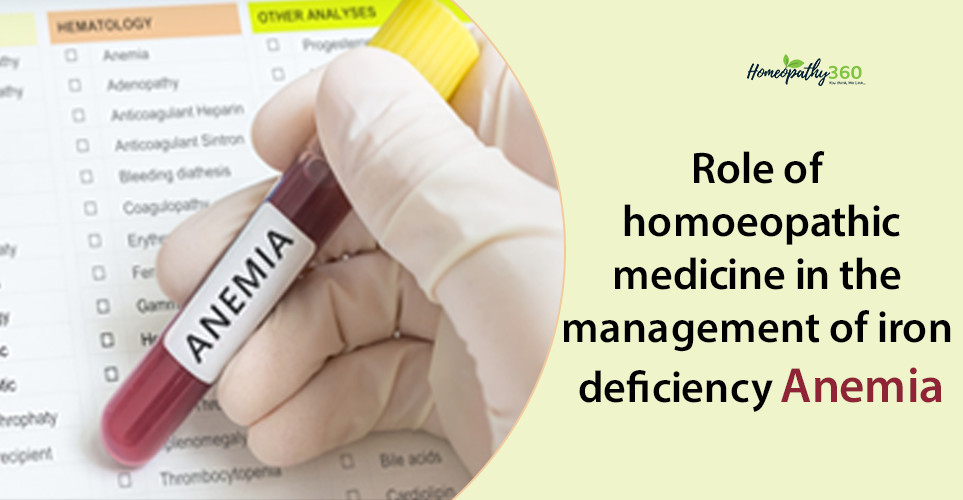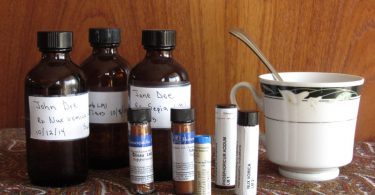
Abstract- Anemia accounts for a majority of the nutritional problem not only across the globe but specifically in India too and principally almost one half of cases are because of iron deficiency. adolescent girls and children are particularly vulnerable groups as accelerated increase in requirement, low dietary intake and poor absorption of iron homoeopathy can correct iron deficiency anemia by dealing with the root cause and help in better assimilation of iron in the body. Number of study and therapeutics indication has been given in text.
Anemia has been a public health problem worldwide. The world health organization (WHO) reports that the prevalence of anemia is highest in children 46.6% and the lowest in nonpregnant women 29.0%.
Epidemiology
GLOBAL BURDEN OF DISEASE-
According to a study by world health organization anemia during 1993-2005 worldwide prevalence of anemia was 25% and 32% in 2010, highlighting the importance of anemia as a public health issue in both developing and developed nations. In 2011 WHO estimated that worldwide prevalence of anemia was 42% in children and 29% in non-pregnant women. In 2013, iron deficiency anemia was found to be the major cause of anemia in 1.93 billion persons accounting for 27% of world’s population and thus iron deficiency anemia (IDA) continues to remain a major health issue. iron deficiency was the fourth and twelfth leading cause of years lived with disability in women and men observed by global burden of diseases study in 2017. The percentage of years lived with disease has decreased over the past three decades from 17.3 to 12% in India. prevalence of IDA is significantly higher in developing countries as compared with developed countries. as per national family health survey-4 prevalence of IDA is highest in preschool children (>60%) followed by adolescent and young adults. prevalence of anemia in India proportion of population with anemia (Hb<11g/dl) 74.3 it is a severe public health problem.
INDIAN SCENARIO–
The national family health survey-3 (NFHS-3) and (NFHS-4) data suggest that the prevalence of anemia in children and adolescent girls and women.
A multicenter, cross-sectional, and observational school-based study urban and rural region of six Indian states (Maharashtra, Gujrat, Tamil Naidu, Punjab Chhattisgarh and Assam) was concluded the overall, 26% of the children (6-18 years) were anemic (girls 29%) Gujrat was affected 37%; rural areas had a higher prevalence of anemia than urban area. A study conducted in rural area in Maharashtra show prevalence of iron deficiency anemia extremely high among adolescent girls
DEFINITION- Anemia refers to reduction in the oxygen carrying capacity of blood, as observed by reduced level of hemoglobin [Hb] concentration and red cell mass [hematocrit (HCT) leading to tissue hypoxia. For practical purposes, Anemia is defined as red blood cell (RBC) mass or Hb measurement <2 SD below the mean for normal population.
Incidence–
Iron deficiency anemia is currently the most widespread micronutrient deficiency and affects nearly 2 billion individuals or around 40% of world population. The highest prevalence of anemia is seen in elderly girls (50%), infants and children of 1to 2 years (48%), school children (40%), and preschool (25%) are affected. 90% of people in third world countries, 74% of children between 6 to 35 Month, 52% of pregnant women and about 35 to 40% of nonpregnant women in developing countries suffering from iron deficiency anemia.
How anemia affects us:
Emotional symptoms of anaemia include: anaemia and depression are two health condition that may have some association. Research suggests that people with anemia may develop symptoms of depression, such as low mood, low self- esteem, and loss of interest in daily activities.
Physical symptoms of anemia include the physical symptoms of anemia, such as fatigue, weakness, and difficulty with daily activities, contributing to feelings of sadness. More directly, the lack of oxygen in the brain caused by anemia can affect how the brain functions and lead to mood disturbance and depression.
Cognitive symptoms of anemia include: iron is an essential element in brain metabolism iron deficiency can cause changes in neurotransmitter homeostasis, decreased myelin production, impair synaptogenesis, and decline the function of basal ganglia, IDA adversely affects cognitive function and psychomotor development apathy, drowsiness, irritability, decreased attention, inability to concentrate and memory loss and increased risk of dementia.
Behavioral symptoms of anemia include: Changes in appetite – either not eating or eating too much, feeling low, anxious and sad, an unusual craving foe non nutritious food. Feeling exhausted regularly without any strenuous work.
STAGE OF IRON DEFICIENCY ANEMIA-
The progression to iron deficiency can be divided into three stages-:
Negative iron balance
Iron deficient erythropoiesis/ latent iron deficiency
Iron deficiency anemia
Negative iron balance
The demands for (or losses of) iron exceed the body’s ability to absorb iron from the diet result from a number of physiologic Mechanism, including blood loss, pregnancy (1-2mg per day), rapid growth spurts in infancy (about 0.6 mg per day) and adolescent, or inadequate dietary intake. under these circumstances, the iron deficit must be made up by mobilization of iron from RE storage sites.
Iron deficient erythropoiesis/ latent iron deficiency
Marrow iron stores are absent at the serum ferritin level is < 15ug/l. As long as the serum iron remains within the normal range, hemoglobin synthesis is unaffected despite the dwindling iron stores. iron is reduced in some tissues. However, hemoglobin is still normal. A large proportion of the Indian population falls in this group.
Iron deficiency anemia
Careful evaluation of the peripheral blood smear reveals the first appearance of microcytic cells; one finds hypochromic reticulocytes. Gradually, the hemoglobin and hematocrit begin to fall in the stage.
RISK FACTOR
The prevalence of iron deficiency anemia varies greatly according to host factor age, gender, environmental, dietary habits, nutritional status, BMI and socio-economic condition. There is a significant relationship between iron deficiency anemia and various predisposing risk factors. frequent tea consumption, poor maternal schooling and poor basic sanitization and life conditions supported by a lot of studies.
These groups of people may have an increased risk of iron deficiency anemia:
Women. Because women lose blood during menstruation, women in general are at greater risk of iron deficiency anemia.
Infants and children. Infants, especially those who were low birth weight or born prematurely, who don’t get enough iron from breast milk or formula may be at risk of iron deficiency. Children need extra iron during growth spurts. If your child isn’t eating a healthy, varied diet, he or she may be at risk of anemia.
Vegetarians. People who don’t eat meat may have a greater risk of iron deficiency anemia if they don’t eat other iron-rich foods.
Frequent blood donors. People who routinely donate blood may have an increased risk of iron deficiency anemia since blood donation can deplete iron stores. Low hemoglobin related to blood donation may be a temporary problem remedied by eating more iron-rich foods. If you’re told that you can’t donate blood because of low hemoglobin, ask your doctor whether you should be concerned.
CLINICAL FEATURE-
SYPTOMS
Extreme fatigue
Weakness
Pale skin
Chest pain, fast heart beat
shortness of breath
headache and dizziness
cold hands and feet
inflammation or soreness of your tongue
SIGN
koilonychia i.e., spoon shaped nails
Pallor of the mucous membrane
angular stomatitis, glossy tongue with atrophy of lingual papillae
splenomegaly
Alimentary system: Gastric acid is reduced, but histamine fast achlorhydria is rare. Motility of the alimentary tract is reduced and this results in constipation. Gastric secretion and gastrointestinal motility recover with treatment.
Cardiovascular changes: Tachycardia, cardiomegaly, high volume pulse, prominent third heart sound, ejection systolic murmurs heard over the pulmonary and aortic areas and in advanced cases signs of cardiac failure. Cardiac murmurs are caused due to decreased viscosity of blood and increased cardiac output.
Neurological manifestations: Apathy, loss of mental alertness, paraesthesia over the extremities, brisk tendon reflexes. When severe anemia develops rapidly, signs resembling raised intracranial tension may be rarely encountered. These include headache, papilledema and retinal hemorrhages. In iron deficiency anemia 10% may show mild splenomegaly, in hemolytic anemias it is over 90%.
INVESTIGATION–
Complete Blood Count and peripheral Smear
Serum Iron Studies
Total Iron-binding Capacity and Transferrin Saturation
Serum Ferritin
Soluble Plasma Transferrin Receptor
Content of Hemoglobin in Reticulocytes
Bone Marrow Examination
PREVENTION-
IRON SUPPLEMETION- all children beyond 4-6month age and low birth weight babies from 1 month onwards should receive a daily
CONVENTIONAL TREATMENT-
1.Dietary Modification
Eat more fruits and vegetables.
No coffee or tea with meals.
Reduce phytic content of cereals and legumes by fermentation and sprouting.
Addition of iron rich foods to the weaning foods of infants.
Promote home gardening.
Consume vitamin c with meals.
2.Improved health services
Deworming and prevention and treatment of malaria (parasitic infections cause ID through loss of blood or destruction of RBCs) could help in controlling anemia .
Education on dietary practices also helps in controlling anemia.
HOMOEOPATHIC MEDICINE WHICH ACTION OF BLOOD-
Phosphorus: This remedy is adapted to tall, slender persons, narrow chested, thin with transparent skin, weakened by loss of animal fluids. There will be great debility with emaciation. There will be hemorrhagic tendencies. Chronic congestion of the head, thirst for cold water. Violent palpitation with anxiety while lying on the left side and weakness and trembling from every exertion.
China Officinalis: This remedy has debility from exhausting discharges and loss of vital fluids. The individuals will have a sallow complexion of face especially after hemorrhage, loss of vital fluids or sexual excesses. There will be heaviness of the head with loss of sight, aversion to exercise, sensitivity to touch, ringing sensation in ears, intolerance to fruits. Great congestion in the chest and violent palpitation of the heart. Trembling with numb sensation.
Ferrum Metallicum: This remedy is best suited for young weak persons, who are anemic with pseudoplethora, who flush easily, have cold extremities, oversensitive to slight noises and whose complaints become worse after any active effort. There is weakness from mere speaking or walking. Red parts become white, bloodless and puffy. There will be breathing difficulty due to surging of blood to chest and anemic murmur can be heard
FERRUM PHOS 6X- Ferrum phos is a haemoglobin enhancer. Ferrum Phos is the most frequently used Homeopathic medicine to increase the haemoglobin level. It can be safely used among people of all age groups. Even during anemia in pregnancy, Ferrum Phos is a safe Homeopathic remedy though the dosage is to be properly handled by the physician during pregnancy. The skin appears pale in persons needing Ferrum Phos and they also experience palpitation of heart and weakness. The pulse rate is quickened. Vertigo and headache also appear as symptoms. Ferrum Phos is also the best remedy for controlling sweat in anemic patients especially at night.
ALETRIS FARINOSA Q–Aletris Farinosa is the best Homeopathic medicine for women suffering from anemia with extreme weakness and fatigue. There is a marked weariness and tiredness all day in such patients. The energy level seems to be markedly reduced and the body feels powerless. Frequent episodes of faintness and vertigo are common and even the face appears very pale. Anemia in women due to repeated abortions is best treated with Aletris Farinosa. Vaginal discharge due to anemia can also be corrected with this medicine. Aletris Farinosa is also effective t for women with anemia due to abundant bleeding during periods.





